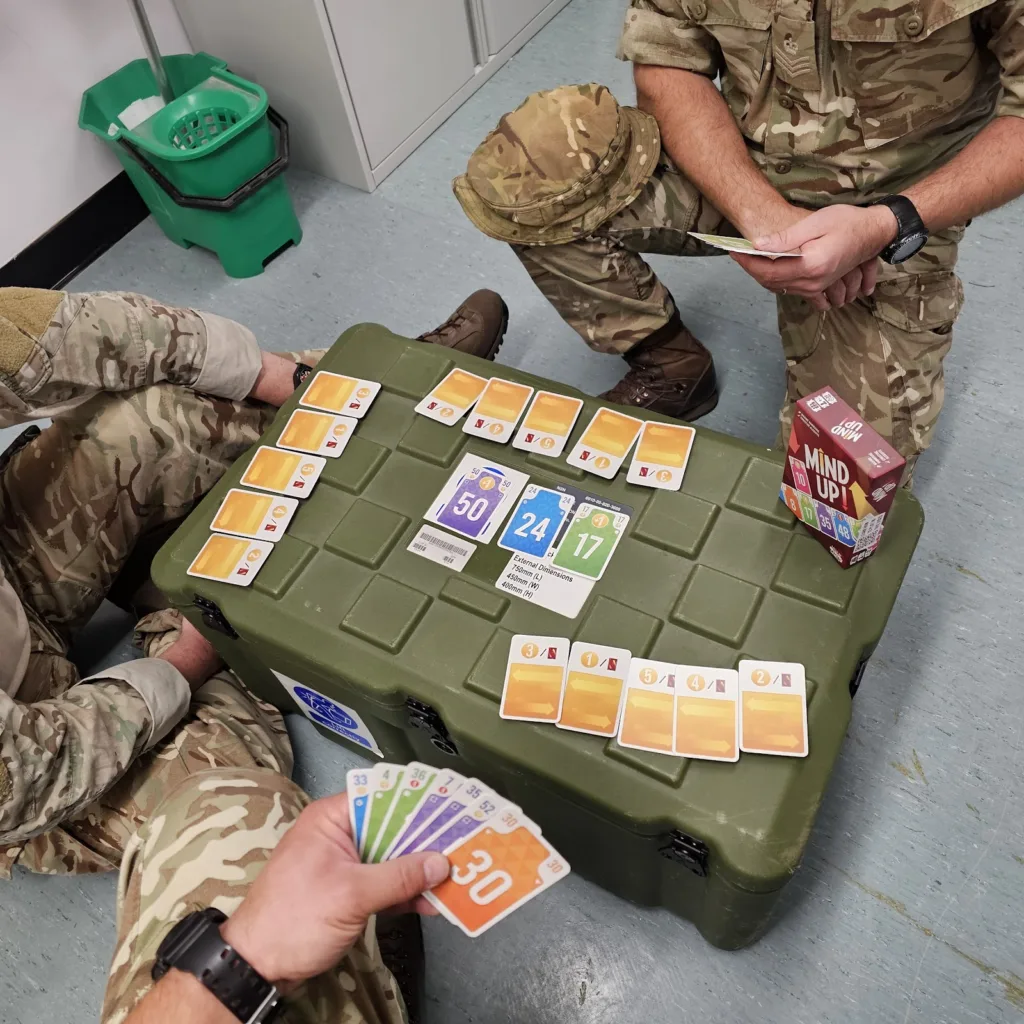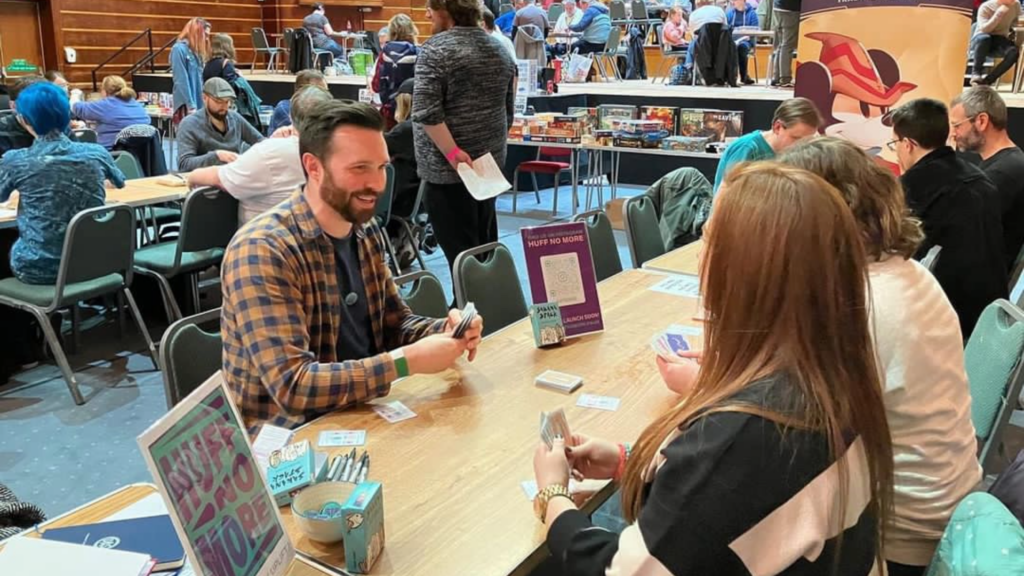I met Scott at AireCon earlier this year, and within minutes of our first conversation, I knew I had to get him on the blog. Here’s someone using board games in ways that genuinely matter, creating connections where they’re needed most. Scott runs Plays with Soldiers, a social media channel focused on board game reviews and miniature wargaming, but it’s his side projects that really caught my attention.
What started as a personal hobby has evolved into something much more significant. Scott is introducing board games to serving military personnel, often in remote deployments where entertainment options are limited. He’s also working with Models for Heroes, a charity that uses model making and painting to support mental health recovery for veterans and emergency service personnel. These aren’t just feel good stories about games bringing people together. This is practical, meaningful work that’s addressing real challenges in ways that traditional approaches sometimes miss.
Enjoy.

Joe: Hello, welcome to the blog – can you tell me a bit about who you are and what brings you to the world of board games?
Plays with Soldiers: Hi, thanks for having me. I’m Scott and I run a social media channel called Plays with Soldiers (PWS). I do board game reviews, as well as miniature wargaming and painting.
PWS has two side quests, if you will. I work with a charity called Models for Heroes, which uses model making and painting to assist with mental health and PTSD recovery for members of the armed forces and blue light emergency services. I ran my first charity event last year in Birmingham, and raised several hundred pounds for the charity by running a Warhammer Kill Team tournament for veterans, serving service members and civilians.
The other is introducing board gaming and miniature wargaming to people in the armed forces who would not normally get exposure. I’m a serving soldier myself and noticed that, especially when deployed with lack of digital connectivity, there is little for soldiers to do except play the same handful of games with a deck of cards.
Joe: Thanks Scott. We met for the first time at AireCon, firstly over a game of Sakana Stack, and then a few others (Splendor, Parade and Heck Meck). In our conversations, I was most intrigued by your side quests.
Let’s dig into them one at a time. Can you tell us a bit more about what Models for Heroes is, and why it does what it does?
Scott: Of course! Models for Heroes (MfH) promotes the use of model making hobbies within former and current Armed Forces and Emergency Service Personnel in the UK. Studies prove that crafts increase happiness and social inclusion, and are a therapeutic and meaningful activity.

Being a medic in the army, I know of numerous veterans and serving members who like to paint minis or make models. They report that an hour or so of slapping some paint on some minis helps them focus on a fixed task, with fixed duration, and ‘tunnel visions’ them into a focus, where they can block out everything else going on around them. Any model painter on here can attest to sitting down to ‘just do one colour’ and then looking up, and three hours have passed…
It’s a big relief when they find out how safe a place it is to get things wrong, or improve slowly, or just take a break for a couple of months and then come back again.
Additionally, some craft options offered by groups to those suffering from mental health issues or PTSD cover things like woodworking and art, but if a person isn’t interested in these things, they won’t interact. Military history is a widespread hobby (indulged in at a variety of levels) within the army, and a person not interested in painting pictures will be interested in a Spitfire Airfix kit, or a WW2 Panzer tank.
The online painting community is, on the whole, a very accepting and welcoming place. I’m a member of numerous groups which see countless posts each month saying “I’m new” or “this is my first model” or “I haven’t painted since I was a kid” and they are met with support, encouragement and open offers of help and suggestions. My local games group runs a painting day every couple of months, and we see the same energy- people bringing down whole paint collections, lending out colours and brushes, bringing down models for newbies to paint and offering advice on different painting methods.

The army, especially, has a ‘do not fail’ mindset. Complete the mission at all costs. It can be scary for a newbie modeller/painter to go from that, to a new community, but it’s a big relief when they find out how safe a place it is to get things wrong, or improve slowly, or just take a break for a couple of months and then come back again.
Joe: Thanks Scott, I can really believe in the benefits you’re describing. So how does it work in practice, who sets up the painting clubs, is it easy to convince people to join in?
Scott: It’s all about setting the entry bar really low. If I turn up with paints, brushes, models, some suggested images of paint schemes etc., then all they need to do is give their time. If they sit there for 20 minutes and decide it’s not for them, they can walk away and they haven’t lost anything. As for getting them to join in, that’s all about stepping up and letting your flag fly, and then seeing who responds. I’m very open about my gaming hobby and it’s frequent that after I’ve been talking to maybe a group or whatever, someone will sidle up on their own and say in a low voice “I used to paint Warhammer when I was a kid. I enjoyed it”… This then gives you the opening… There’s still a bit of stigma, especially around younger soldiers, about wargaming. If you can get them to turn up, they will then get comfortable, and will then see others from their Regiment, who they didn’t know painted. It’s a bit of a cross between Fight Club (except we do talk about Paint Club) and that first turn in the game Werewolf, when all the wolves open their eyes and see their allies. It leads to a lot of “hey, I didn’t know you were into this…”
Gaming groups are much easier to run spontaneously though. Recently, I was on a course down at Royal Military Academy Sandhurst, and I stood up at the end of class and said, “I have a big bag of games. Meet me in the dining hall at 8, if you’re interested”. I had 8 people turn up. One was already a gamer, one played party games with her family, but the other 6 were completely new. We played small games for about 2 hours, then everyone left. The following day, numerous people (who hadn’t attended) asked me how it had gone and seemed genuinely interested in what we had got up to. I think if I had been there a few more days, more would have come, after seeing others had taken it up.
It’s all about setting the entry bar really low. If I turn up with paints, brushes, models, some suggested images of paint schemes etc., then all they need to do is give their time.
Joe: Thanks Scott. So when you told me about introducing games in this way it sort of blew my mind a little bit. Can you help me get a sense of what the military would be doing in their downtime usually?
Scott: It kind of depends where we are! At home, in barracks, we have all the usual mod cons. So people play on consoles a lot. First person shooters are popular, no surprise. Or people go to the gym, go out, watch TV.
Being on deployment is different. The main issue is data access is usually restricted, even in ‘safe’ countries like Kenya. People frequently play cards. A standard 52-card deck can be found pretty much everywhere, and most military welfare organisations send out branded packs of cards. Combine this with alcohol also being restricted, or outright banned, and it leads to people sitting around, usually in the dining facility because of tea and coffee access in the evening, chatting and playing cards.
When deployed with lack of digital connectivity, there is little for soldiers to do except play the same handful of games with a deck of cards.
Joe: And so in both of those situations, you’ve started using board games as a way of bringing people together. What’s that like, and what does it do to the people playing together in a different way?
Scott: At first people are wary… They see you playing a game in the dining area, they’ll wander over and see what’s going on. They may stop and watch for a bit and then wander off. The key is consistency though. If I’m in the same spot, playing games at a regular time, people will come back, and they’ll watch for longer. Game choice is important at the point that you invite them in. If I were to present Brass: Lancashire, their eyes would glaze over and they’d switch off. In the past, I’ve used Skull. “Can you play poker? Yes? OK, well it’s a bit like that. Betting and bluffing…” will get them involved. Then games can escalate, to Sushi Go, Splendor or whatever. It’s about climbing a ladder, gradually increasing the difficulty, or introducing a new mechanic.
When we deploy, we are a variety of job roles and cap badges. Infantry, medics, mechanics, signallers, we all go together. Some are more open to new experiences, and games, than others. But again, consistency is key. If people see someone they know, there’s more chance they’ll sit down.

The great thing though is how these people then interact away from the table. On Tuesday night, a group is sat playing a game. On Thursday, the infantry may need someone to run some medical training, and they remember that a medic played with them. So they go looking for him, and we help out. Can you run some infantry training for our medics in return? Yes? Great! We’re forging those cross-role bonds, which makes us stronger as an organisation. It’s almost like an unofficial bit of horse-trading, bypassing the Chain of Command and not waiting for things to go up and down lines of communication.
Sitting at a table with someone means you now know them as Steve, or Richard or Sarah, and not just a signaller, or mechanic.
Part of it is also about image. Stereotypes exist about everyone in the army. But sitting at a table with someone, means you now know them as Steve, or Richard or Sarah, and not just a signaller, or mechanic.
Joe: This is super powerful, and something you find all over the tabletop gaming space. Let’s see if we can dive in a little deeper. Why does it work so well? What about the shared experience of something as simple as a game means that you can walk away from the table with such a different type of relationship with someone?
Scott: I think it focuses your attention. If you go to a football game, you’re thinking of the game, the players, you’ll be talking about the team to the person next to you. You stand in a bar and someone with the same football top next to you will strike up a conversation. Board games are the same. You’re sitting at a table, and you’re there to play a game. You have a shared interest with everyone else there. Even if you’ve not played the same games, or even like the same mechanics, there will be shared ground between you at some point.
I think social media has created a society where most of us will wear a mask. A public face that we want others to see, and which can be switched out when with different groups of people. A game, especially the simpler ones I use to introduce people to gaming, lets people come together but keep that mask in place. If they don’t like it, they can leave, and no-one is any the wiser. If they like it, and they stay, they can start to lift that mask a little, slowly for some, quickly for others, and start making those connections.

I’ve always been very visible about my hobby, and will talk to anyone who stands still long enough, about it. I was trying to explain conventions to a co-worker and they said “but what if you saw someone you knew? And they saw you?”, and I explained that it was actually an ideal situation, because then you both know you’re geeks, and you’re being yourselves and you’ve just found another ally or maybe friend. No-one pays good money to go to a con just to laugh at nerds, so it’s a safe space.
Joe: This is quite lovely Scott and so well put. If I may be so bold as to add a thought here. There’s safety in a shared set of rules. There’s clarity of expectation when everyone is playing the same game. So a game builds the foundation of a relationship that can then be explored later outside of the rules of the game. You end up with a shared memory of an adventure had together, perhaps a battle won, lives saved or puzzles completed. There’s something to build everything else from at that point.
OK let’s round this out, firstly what are your go-to games for these introductions? What works really well. And then, tell us how we can support you and the work you do?
Scott: I think you hit it when you talk of a shared set of rules. One of the intro games I use is Skull. Similar to Poker, so a newbie has something to grab onto instead of being cast adrift in a sea full of unfamiliar mechanics. My go-to games for complete newbies are Sushi Go (cards are colour co-ordinated, and have the points written on them, so no need to look at a rule book), Zombie Dice (push your luck mechanic, leads to a lot of player interactions, baiting, encouraging and shouting when it all goes wrong and they crash out), leading up to Splendor (for resource gathering/persistent resources and planning ahead) and Carcassonne (fixed game length, bit of planning and luck) and recently I added Tinderblox (really simple and surprisingly popular. I’m presuming as a dexterity game, it appeals more to a section of people who are more practical and hands-on minded than academically minded).
As for supporting, follow me on Instagram and YouTube. Last year I ran the charity event for Models for Heroes and now I’ve got certain work-life things tied down, I’m looking to run again at the end of November. A charity game day, for forces personnel, veterans and civilians, getting together, playing games and having a great time sharing a hobby, while raising some money. Keep an eye out for posts on social media about it. It’ll be held probably in Birmingham again.
Of course, if you have some spare money lying around, down the back of the sofa, I would suggest making a donation directly to the charity!
Scott’s work reminds me why I love this hobby so much. Yes, board games are fun, but they’re also tools for connection, healing, and building understanding between people who might otherwise never interact. The fact that something as simple as a deck of cards or a box of Sushi Go can break down barriers and create lasting relationships speaks to the fundamental human need for shared experiences.
If you’re inspired by Scott’s approach, consider how you might use games to build bridges in your own community. Whether it’s introducing a colleague to your favourite game, volunteering at a local charity, or simply being more open about your hobby, small actions can have meaningful impacts. The gaming community has always been welcoming, but stories like Scott’s show us how that welcoming spirit can extend far beyond our usual circles.
You can find Scott on Instagram and YouTube as Plays with Soldiers, and if you’d like to support Models for Heroes directly, you can find them online. Sometimes the best way to support great work is simply to share it, so if Scott’s story resonates with you, pass it along.



Pingback: Diary #69 – Flight – Master of Olympus